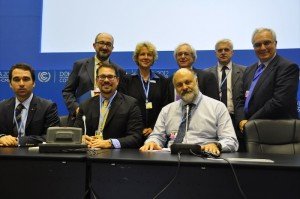
Scientists, policy makers and Ngo contributed a discussion on needs and perspectives of adaptation strategies in five different Regions with similar climate conditions. We publish here the outcomes of the CMCC’s side event at COP18 in Doha “Mediterranean-Climate Regions: ready for a successful adaptation to present and future climate?” (December 4, 2012). The side event was a very good opportunity and occasion to build up the process on adaptation to climate change, participate in the UNFCCC debates and launch ideas to set up the Mediterranean City Climate Change Consortium MC-4 www.mc-4.org as part of its Action Plan.
Background Information
Climate change adaptation and mitigation are linked challenges and confronting them together is essential. Adaptation, as mitigation, requires a local approach, the involvement of all stakeholders, decision-makers, tools, data, science, knowledge, communication and fighting political barriers.
A relationship was established among the five regions in the world with a Mediterranean climate – southern California, the Mediterranean basin, South Africa (Cape Town), Australia (west coast) and Chile – under the Mediterranean City Climate Change Consortium – MC-4. This was developed at its first conference last June 2012 in Los Angeles on “The Mediterranean City: A Conference on Climate Change Adaptation”. Collaboration has been initiated between cities to realistically adapt to the current and future impacts of climate change as they similarly affect these five regions of the world. Collaboration among partners with similar climate conditions, physical infrastructures and social systems is a key issue. This fundamental aspect can help adopt decisions in a quicker and more efficient manner at the right level of governance.
Participants
 The side event was opened by the Moderator, Riccardo Valentini, Director of the “Impacts on Agriculture, Forest, and Natural Ecosystems” division and Professor of Forest Ecology Department for Innovation in biological, agro-food and forest systems -DIBAF – University of Tuscia,Viterbo, Italy.
The side event was opened by the Moderator, Riccardo Valentini, Director of the “Impacts on Agriculture, Forest, and Natural Ecosystems” division and Professor of Forest Ecology Department for Innovation in biological, agro-food and forest systems -DIBAF – University of Tuscia,Viterbo, Italy.
The Mediterranean basin was represented by Antonio Navarra (President of Euro-Mediterrenean Center on Climate Change – Italy), Nicolas Beriot (Secretary General of the National Observatory on the impacts of climate change, IPCC Focal Point – France), Josep Enric Llebot (Secretary of State for Environment and Sustainability, Government of Catalonia – Spain) and Kadir Demirbolat (Head of Department Ministry of Environment and Urbanization, Climate Change Department – Turkey).
The Californian region was covered by Michael McCormick (Appointee of California’s Governor, Jerry Brown and Local and Regional Affairs Policy Advisor in the Governor’s Office of Planning and Research) and Louis Blumberg (Director of the California Climate Change program of the Nature Conservancy in San Francisco).
The Australian region was represented by Barbara Norman, Foundation Chair, Urban and Regional Planning, Faculty of Business and Government, University of Canberra.
Last but not least, South Africa counted on the participation on the phone of Bongani Mnisi, Regional Manager: Biodiversity Management, Cape Town.
Speechs
Prof. Valentini opened the session addressing the main challenges in Mediterranean climate regions: they are getting hotter and dryer. He referred to the example of the change in wine production in the Tuscany region, on the anomalies in spatial yearly green water areas, the shift of productive areas, the mean adaptive capacity of the land. He referred to the MC4 Consortium which has started to take action. Our Mediterranean climate regions are very well placed to tackle adaptation. They count on the engagement of the governments and partnerships among all actors. Smart cities and smart solutions for biodiversity, products, forest, water, waste and climate change are best placed to strive to better prepare and cope with adaptation and what science is giving into this dialogue.
Dr. Navarra referred to the clear trend that we are moving into hotter and warmer climate in the next few decades: sea level is rising, the Mediterranean sea is warming up, salinity is increasing, there is a need to quantify uncertainty in the near future, water is the main problem in the Mediterranean basin in terms of availability and adaptation. The current mega trends remain nowadays: fragmented institutional framework impacting regional governance, divergent demographic trends in the North/South/East/West, leading to import migration flows and labor mobility, natural resources becoming more scarce with these new environmental threats. The areas in which climate will impact very largely will be on migration flows, on health risk creating conflicts around water scarcity, increasing solidarity, food and energy innovative thinking and techno green growth scenarios will play a key role in tackling the new challenges. Science can offer good support of adaptation for effectively cope with climate change in the whole Mediterranean area. This is a pressing issue and the scientific community can help in the planning area. Previously climate change research has been undertaken too often on a sector by sector basis and the problem was rarely tackled as a whole.
Mr. Beriot gave a high importance to the knowledge that already is there and is developing. We are still ignorant about the natural and climate limits, but we are in the right directing acquiring this missing knowledge through studies (like the ones in France which followed the heat wave of 2003, which motivate straight action work on adaptation and proved positive). There are currently many studies on vegetation, for instance, but these will only bring part of the solution. We still need to find structural changes applicable to a city. Here we make use of some capacity, but still a lot remains to be done. Financing, skills and resources means are crucial to create prosperous cities. We are aware of the limits of the adaptation capacity of our cities and we know that citizens are willing to act, but the response to the challenge will only come from a joint action among governments, leaders, followers, citizens. Legal aspects remain crucial: it has to be mandatory that adaptation is taken into account.
Mr Llebot referred to the Catalonian Strategy for adapting to climate change 2013-2020. He is responsible for an administration facing problems with urban planning and risk in coastal areas. The Catalan strategy is about evaluation and balance. The first goal is to determine in the greatest detail possible the specific and global impacts climate change will cause, and is causing, on the various natural systems (coasts, deltas, seas, freshwater, forests, mountain chains, glaciers) and socio-economic sectors of Catalonia (agriculture, tourism, energy, forestry, civil defence, water management, health, fisheries), given the greater body of knowledge currently available. The second general objective is to identify, foster and implement adaptation measures that reduce the vulnerability of the natural systems and sectors. More than 100 measures have been identified. The Catalan Strategy for Adapting to Climate Change promotes the progressive implementation of: more decentralised institutional structures that encourage social participation; flexibility of water supply, energy generation and infrastructure systems; cross-cutting policies integrated in the various spheres and sectors and saving and efficiency improvements in the gradual comprehensive restoration of ecosystems, instead of aiming to create new demand. A key question remains if urbanization plans should go on or stop due to the risk of climate change (as it might be the responsibility for the administration in case of disaster in 20 years time when they give authorisations in case of flooding).
Mr. Demirbolat presented how Turkey is positioning itself in the Mediterranean basin. They have a new Climate Change adaptation Strategy. The country has a growing population, 60 % live in cities. There are potentially, some advantages but also some challenges that the recently adopted national strategy is tackling. Turkey is ready for a successful adaptation to present and future climate, Turkey is already leading on the example with its challenging strategy as a non EU country, showing how similar climate conditions, physical infrastructures and social systems experience can be easily shared among regions and the borders are not a limitation.
Mr. McCormick highlighted the Climate Change Adaptation Strategy adopted in 2009 based on state buildings, infrastructure, but did not tackled much the cities perspective. California is positioning very high in the US now in terms of tackling climate change adaptation. California has managed to create pilot programs to support climate change planning in this Mediterranean Climate Region. A lot of things have been done. In 2013, a new climate preparedness strategy will be implemented. In California they cannot act on land use changes but they need to prepare for climate change impacts. The State of California is doing a lot of work on downscaling, on IPCC, assessing what the impacts are going to be, evaluating what cities can do, how to support science. An “adaptation planning guide” was released a few months ago (available in the Government portal), which is aiming at working with local stakeholders, how to address preparedness through an emergency agency. California is currently doing a lot, some times event too much that is difficult to have consistency. The State is also giving a lot of importance to technology in terms of tackling climate change (with super computers in all the areas, eg. Bay area, Los Angeles, San Diego, which all deal with adaptation in different ways). LA is trying to do the downscaling on their own to support policy making at a small scale and Internet has been very good in disseminating information in general terms. We need to understand what the needs are. We need to know more on dowscaling at state level. This is the way to link funding to process to create change; providing technical support. We are still missing indicators on adaptation and preparedness (as it is much easier to have indicators on mitigation – and the challenge remains on adaptation).
Mr. Blumberg presented things from a different perspective, from an NGO point of view. Familiar risks make things real and is this precisely what makes the challenge become a local challenge. Key decisions are to be taken at the local level, working on preparing solutions at the local level. Absent a change, government will allocate these funds to building traditional hard, or “grey” infrastructure,” such as sea walls and levees that degrade natural resources and biodiversity. Nature-based actions (“green infrastructure”) can both reduce climate driven risks and provide many other benefits that engineered actions do not. Nature-based responses are quick to implement, flexible, cheaper, provide habitat for wildlife, nursery ground for fish and related jobs, recreation, and quality of life. To help local planners evaluate the impacts from multiple response scenarios, the Nature Conservancy is developing a web-based decision support tool, with local partners in Ventura County, California. Nature based solutions are part of an integrated approach to build Climate Ready communities that make decisions and implement actions that reduce GHG emissions, store carbon, reduce risk to people and nature, give priority to green infrastructure where feasible, create public and political support and generate revenue for conservation. We feel the need for an integrated and “climate ready communities” (give priority to “green”). The responsiveness between mitigation and adaptation is difficult to communicate, but if people are threaten by fires for instance, they understand the problem directly and can give a quick response.
Prof. Norman, as a spatial planner, referred to a broader consideration: we need to better connect, plan, communicate with the policy makers and the regional communities. Cities and climate change in Australia are interlinked: innovation in a southern land of fire, flood and drought plays a key role. The long-term vision is the one that needs to drive our actions when we develop strategies. Working with politicians is a challenge, possible and important. Talking about risk management is most likely the best approach we can take to really understand the problem and communicate with the policy makers. Urban adaptation is the urban challenge, is the double challenge of adaptation and urbanization. Local measures can be taken but they need government support. Coastal adaptation remains crucial in Australia since most people live there. Engaging with the communities is the key to make a difference. Climate change threatens our regions in many ways. Increased drought, wildfire and coastal erosion and high heat days all threaten human well-being and the regions’ diverse biodiversity and natural resources. These threats are familiar but amplified by climate change. Innovative solutions help regions in the Southern hemisphere respond to climate change. Citizens can and have to be part of an integrated strategy to address the cause of the problem that will help communities be ready for the future. Planning for risk and uncertainty across landscapes is the challenge.
Mr. Mnisi stated the importance that biodiversity plays in Cape Town. Integration is a fundamental aspect. We need more guidance into planning i.e. science modeling, and then need for local action. We need to consider more mitigation actions rather than adapting afterwards at any cost. In order to develop a world city, the city of Cape Town has developed various strategic plans to address the challenges of climate change adaptation. These include an Integrated Development Plan, Spatial Development Plan Integrated Metropolitan Environmental Plan and other Climate Change action plans. Considering the role that local government can play in addressing the challenge of adaptation, the city of Cape Town has really endeavored in addressing the challenges of climate change adaptation through biodiversity conservation actions considering the high percentage it occupies in this city. The city of Cape Town has adopted a Biodiversity Network, a map that indicates sensitive areas as well as high biodiversity areas. This map has become part of the planning fabric, which guides further development in the City. Working with various partners including local stakeholders, the city has developed a climate change adaptation corridor, which is one of the two important corridors in the Western Cape, South Africa. This corridor promotes three core values i.e. the Resource Value (the protection of the Witzands Aquifer, which is critical for water security in Cape Town); socio economic value (ideal for skills development projects and economic development opportunities through Tourism) and of course, the ecological functioning and Biodiversity Value.
Conclusions
1. This side event was an example of good practice in reinforcing the newly established relation among the five Mediterranean-climate regions and contributing to the setting up of the MC-4 network.
2. The event raised the awareness of the adaptation action needed at the local level and of an integrative process, which cannot come on its own and has to go in parallel with mitigation action.
3. Engaging with the communities is the key to make a difference.
4. Dissemination of best practices and technological solutions, particularly for developing smart climate cities is also recognized an important step, as reported by several ongoing projects, such as the BioEnPro project by Sea Marconi.
5. Mediterranean-climate regions are looking for other opportunities to foster debate. We can try to foster cooperation in all directions and means.
6. We are facing new challenges, we have a lot of ongoing initiatives, therefore we need to combine science, we need IT tools, better governance, we need appropriate political and legal frameworks, we need to exchange best practice, better tackle risk management, we need more risk managers, cost and benefits analysis…
7. Financing remains a crucial aspect to tackle, but collaboration among all level of governance and partnerships with all actors affected, including the private sector, is the fundamental key to address the challenge in the most appropriated way. Each affected has a special responsibility.
8. Impacts from climate change are already affecting natural and human communities, and Mediterranean regions are particularly at risk – with more extreme weather events like flooding, wildfire, and drought projected over the next several decades. Local, state and federal governments are beginning to respond by allocating funds to projects aimed at protecting people and property from these climate-amplified events.
9. The Mediterranean basin surely can be a model to other regions in tackling adaptation, we have a lot of expertise and tools that can be shared among all of us, and this is part of the success, the transfer of knowledge.
10. Since there were four State representatives in the panel, the political message was clear to them to pass onto the Heads of State discussing during this COP18 and beyond: collaboration is needed at all levels of governance and the right tools, and data need to be put in place for the efficient implementation of adaptation (and mitigation) measures.
Picture CC by World Resources at Flickr.com


